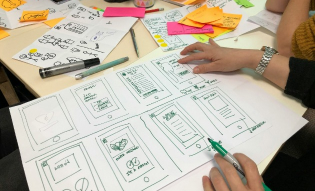In today’s digital age, user experience (UX) and user interface (UI) design have become pivotal in determining the success of a product or service. Whether it’s a website, mobile app, or any digital platform, the design and usability can make or break user engagement and satisfaction. This blog explores the critical importance of UI/UX design and how it impacts both users and businesses.
What is UI/UX Design?
Before delving into its importance, let’s clarify what UI and UX design entail.
User Interface (UI) Design refers to the visual elements of a product. It includes everything users interact with on the screen, such as buttons, icons, spacing, typography, and color schemes. The goal of UI design is to create an aesthetically pleasing interface that aligns with the product’s brand identity.
User Experience (UX) Design focuses on the overall feel and functionality of a product. It encompasses the entire process of acquiring, integrating, and using the product, including aspects of branding, design, usability, and function. The aim of UX design is to enhance user satisfaction by improving the usability, accessibility, and pleasure provided in the interaction with the product.
The Importance of UI/UX Design
1. First Impressions Matter
A well-designed UI creates an immediate visual appeal, capturing the user’s attention and encouraging them to explore further. First impressions are formed within seconds, and a clean, intuitive interface can make a positive impact, fostering trust and interest in your product.
2. Enhances User Satisfaction
Good UX design ensures that the user’s journey through the product is smooth and enjoyable. When users find what they need easily and can accomplish tasks without frustration, their overall satisfaction increases. This positive experience can lead to higher user retention rates and positive word-of-mouth referrals.
3. Increases Engagement and Retention
An intuitive UI coupled with a seamless UX keeps users engaged and encourages them to return. When users can navigate effortlessly and find value in your product, they are more likely to stay longer and explore more features, which can lead to higher engagement rates and customer loyalty.
4. Boosts Conversion Rates
Effective UI/UX design can significantly impact your conversion rates. A user-friendly design guides users through the conversion funnel smoothly, reducing drop-off points and making it easier for them to complete desired actions, such as making a purchase, signing up for a newsletter, or filling out a form.
5. Reduces Development Costs
Investing in UI/UX design early in the development process can save time and money in the long run. Identifying and addressing usability issues during the design phase prevents costly changes and rework after the product is launched. This proactive approach ensures a more efficient development process and a higher-quality final product.
6. Fosters Brand Loyalty
A positive user experience contributes to brand loyalty. When users have a pleasant and efficient interaction with your product, they are more likely to become repeat customers and advocates for your brand. Consistently good UX builds a strong, trustworthy brand reputation.
7. Differentiates from Competitors
In a crowded market, UI/UX design can be a key differentiator. A product that stands out with its ease of use and visual appeal has a competitive edge. Users are more likely to choose and stick with a product that offers a superior experience over one that is challenging to use or visually unappealing.
Conclusion
UI/UX design is not just about making a product look good; it’s about creating a functional, enjoyable, and meaningful experience for users. By prioritizing UI/UX design, businesses can enhance user satisfaction, increase engagement and retention, boost conversion rates, reduce development costs, foster brand loyalty, and stand out in the competitive market. In essence, investing in UI/UX design is investing in the success and longevity of your product.

